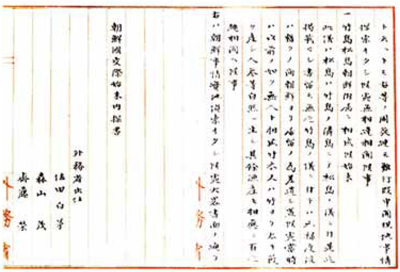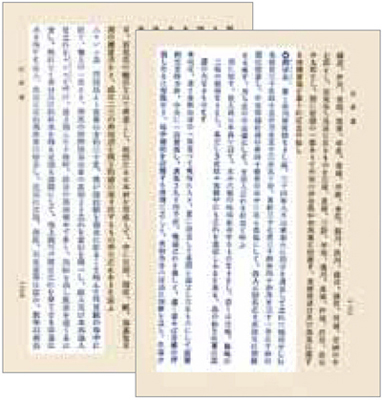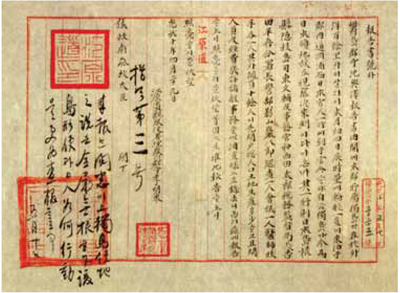- Dokdo in the East Sea
- Controversies surrounding Dokdo
- The History of Dokdo
Dokdo in the East Sea
Table of Contents Open Contents
The Japanese Meiji government Recognized that ‘Dokdo is Joseon Territory’
Although the Meiji government[note 005] incorporated Dokdo into Japanese territory in 1905, previously it had recognized the island as belonging to Joseon.
Immediately after the Tokugawa Bakufu had been toppled, the new Meiji government sought to quell domestic troubles through overseas expansion. In 1869, under the direction of the Dajōkan (The Great Council of State), Japan’s most powerful government organ, the Foreign Ministry secretly sent Foreign Ministry officials including Sada Hakubo to Busan.
Their mission was to secretly investigate the possibilities for a reopening of diplomatic relations with Joseon. One thing that stands out from the directives given to the investigators is the order to perform a “Full Accounting of Ulleungdo and Dokdo, Islands which are part of Joseon Territory.”

“A Confidential Inquiry into the Particulars of Foreign Relations of Korea”(1870) shows that Ulleungdo and Dokdo belong to Joseon.


The draft of a plan by the Home Ministry, and a written order showing that the Dajōkan had ruled that Ulleungdo and Dokdo had nothing to do with Japan (1877)

Here is what preceded.
On October 16, 1876, the Japanese Home Ministry received an official message from Shimane Prefecture asking whether Ulleungdo and Dokdo should be included within its territory. After months of serious deliberation, the Japanese reached the conclusion that since 1696 Ulleungdo and Dokdo had been the territory of Joseon and “had nothing to do with Japan.”

This document, owned by the Murakami family, conveying the fact that Dokdo and Ulleungdo were part of Gangwon-do in Joseon, was recorded in the map brought by Ahn Yong-bok when he visited Japan (1696)

However, the Home Ministry of the Meiji government believed that “deciding whether territory belongs to us or not is an important decision” and asked for a final ruling from the Dajōkan on March 17, 1877.
On March 20 of the same year the Dajōkan drafted the written order saying that “The view circulating among us shows that the other island besides Ulleungdo has nothing to do with Japan.” On March 29, this order was officially sent to the Home Ministry. On April 9, the Home Ministry forwarded this written order to Shimane Prefecture and ordered it not to incorporate Ulleungdo and Dokdo.

The “Map of Joseon’s East Coast”(1876) and “Joseon Coast Pilot”(1899), published by the Japanese Ministry of the Navy, both show Dokdo as belonging to Joseon

If Japan had wanted to recognize Dokdo as Japanese territory, it would have obviously labeled the islands as such in the “Map of the Northwest Coast”(Seihokuganzu) or the “Japan Coast Pilot”(Nihon suirōshi). But it did not do so. At this time an employee of the Ministry of the Navy submitted “A Proposal to Develop Matsushima”(Matsushima kaitakunogi)[note 006] to the Foreign Ministry in 1876. What he referred to as “Matsushima” was actually Ulleungdo, and records show that he had performed a survey around the island. But if Japan had already laid claim to Ulleungdo at that time, would not survey records for this area already have existed?
Not only the Meiji government but also Japanese citizens were certain that Dokdo belonged to Korea at this time.

“The Guide to Fishing in the Korean Sea” clearly indicating that Dokdo was subordinate to Ulleungdo, under the jurisdiction of Gangwon-do (1903)

Even Nakai Yosaburō, who had ultimately provided the opportunity for Japan to seize Dokdo, wrote in 1904 that he along with other Japanese fishermen recognized “Dokdo as an island subordinate to Ulleungdo, which is part of the territory of Joseon.” This is recorded in the Summary of Business in Dokdo (Jigyōkeiei gaiyou) which he penned himself in 1906. This shows that Dokdo was unmistakably Joseon territory, and until the Japanese carried out their plan to seize it, no countries had fought with Joseon over this island nor had Koreans ever given up claim to it.

The section on Military Administration in the Mangi yoram defines both Ulleungdo and Dokdo as the territory of Usan-guk

Even before the Japanese seized Dokdo in 1905, they had already tried to seize Ulleungdo. In the seventeenth century, Japan took advantage of Joseon’s weakened state, resulting from the Hideyoshi Invasions of 1592 to 1598 and the Manchu Invasion of Joseon in 1636, to travel to the island as they pleased. The Japanese hoped to use their constant comings and goings to attach Ulleungdo to their national territory. However, thanks to the efforts of Ahn Yong-bok and the Joseon government’s resolute measures, the Japanese efforts to seize Ulleungdo failed.

“Imperial Ordinance No.41” which placed Dokdo under the jurisdiction of the Ulleungdo Magistracy (1900)

Even though Japan unilaterally incorporated Dokdo into its national territory on January 28, 1905, it did not announce that it had done so for some time. Only after more than one year had passed on March 28, 1906, when officials from Shimane Prefecture visited Ulleungdo, did they notify others of the incorporation.

Japanese officials from Shimane Prefecture visiting Ulleungdo and telling Joseon officials that Dokdo had been incorporated by Japan (1906)

Shim was surprised to hear such news, and immediately reported this the next day to Yi Myeong-nae, the Governor of Gangwon-do. Yi also recognized the importance of the situation and relayed the report verbatim to a minister in the Uijeongbu, or the State Council, which was the highest government organ.

A document by Yi Myeong-nae, the Governer of Gangwon-do, conveying the Ulleungdo Magistrate’s report on Japan’s incorporation of Dokdo (1906)

However, Magistrate Shim Heung-taek, who had issued the original report, soon retired from his post. Even if Shim had stayed on, it would have been very unlikely that he received Park’s order, due to the Korea-Japan Agreement for the Commissioning of Communications Facilities (April 1905), which put the control of Joseon’s post, telegraph, and telephone system into Japanese hands.

Itō Hirobumi and other Japanese officials celebrating the conclusion of the Protectorate Treaty in this commemorative photograph (Treaty of 1905)

However, at that time Japan justified its incorporation of Dokdo by arguing that the Korean Empire did not strongly object to this action.
- [note 005]
- During the reign of the Meiji Emperor, this modern, reformist government shattered the Bakufu and restored monarchical rule to Japan. Under the banner of “Rich Country, Strong Military,” the Meiji government took modern countries in Europe and America as models to foster capitalism and strengthen the military. Internationally, Japan had become an imperialist country, and although it submitted meekly to Europe and America, it prosecuted a policy of compulsion and invasion against various nations of Asia.
- [note 006]
- In 1876 a Japanese man named MutōHeigaku discovered an island rich in natural resources while traveling to and from Vladivostok. He petitioned for development of the island. When the Japanese Ministry of the Navy deployed a warship to survey the island on September 1880, they learned that Matsushima was none other than Ulleungdo.
- [note 008]
- As illegal visits to Ulleungdo began occurring more frequently, the Joseon government conducted a detailed investigation into the situation of the island and announced the “Order to Develop Ulleungdo”(Ulleungdo gaecheokryeong), which encouraged immigration to the island. The government began offering incentives to immigrants by waiving their taxes for five years and allowing the construction on the island of transports destined for the Yeongnam and Honam regions.
- [note 009]
- Japan forced this treaty upon Joseon to deprive it of the right to conduct its own foreign affairs and to turn it into a colony. After the conclusion of this treaty, the Japanese established the Residency-General of Korea, supervised the administration of the country, gained the power to affect any policy, and obtained the authority to assemble the country’s military forces.
[note 005]
Meiji government
During the reign of the Meiji Emperor, this modern, reformist government shattered the Bakufu and restored monarchical rule to Japan. Under the banner of “Rich Country, Strong Military,” the Meiji government took modern countries in Europe and America as models to foster capitalism and strengthen the military. Internationally, Japan had become an imperialist country, and although it submitted meekly to Europe and America, it prosecuted a policy of compulsion and invasion against various nations of Asia.
닫기
[note 006]
Proposal to Develop Matsushima
In 1876 a Japanese man named MutōHeigaku discovered an island rich in natural resources while traveling to and from Vladivostok. He petitioned for development of the island. When the Japanese Ministry of the Navy deployed a warship to survey the island on September 1880, they learned that Matsushima was none other than Ulleungdo.
닫기
[note 008]
Order to Develop Ulleungdo
As illegal visits to Ulleungdo began occurring more frequently, the Joseon government conducted a detailed investigation into the situation of the island and announced the “Order to Develop Ulleungdo”(Ulleungdo gaecheokryeong), which encouraged immigration to the island. The government began offering incentives to immigrants by waiving their taxes for five years and allowing the construction on the island of transports destined for the Yeongnam and Honam regions.
닫기
[note 009]
Korea-Japan Protectorate Treaty (Treaty of 1905)
Japan forced this treaty upon Joseon to deprive it of the right to conduct its own foreign affairs and to turn it into a colony. After the conclusion of this treaty, the Japanese established the Residency-General of Korea, supervised the administration of the country, gained the power to affect any policy, and obtained the authority to assemble the country’s military forces.
닫기








